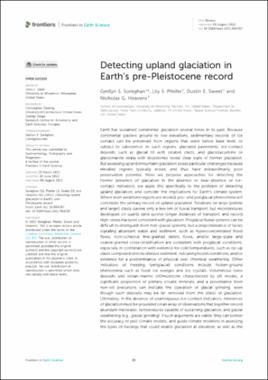| dc.contributor.author | Soreghan, Gerilyn S. | |
| dc.contributor.author | Pfeifer, Lily S. | |
| dc.contributor.author | Sweet, Dustin E. | |
| dc.contributor.author | Heavens, Nicholas G. | |
| dc.date.accessioned | 2023-01-06T22:54:03Z | |
| dc.date.available | 2023-01-06T22:54:03Z | |
| dc.date.issued | 2022-08-08 | |
| dc.identifier.citation | Soreghan GS, Pfeifer LS, Sweet DE and Heavens NG (2022), Detecting upland glaciation in Earth’s pre- Pleistocene record. Front. Earth Sci. 10:904787. doi: 10.3389/feart.2022.904787 | en_US |
| dc.identifier.uri | https://hdl.handle.net/11244/336979 | |
| dc.description.abstract | Earth has sustained continental glaciation several times in its past. Because continental glaciers ground to low elevations, sedimentary records of ice contact can be preserved from regions that were below base level, or subject to subsidence. In such regions, glaciated pavements, ice-contact deposits such as glacial till with striated clasts, and glaciolacustrine or glaciomarine strata with dropstones reveal clear signs of former glaciation. But assessing upland (mountain) glaciation poses particular challenges because elevated regions typically erode, and thus have extraordinarily poor preservation potential. Here we propose approaches for detecting the former presence of glaciation in the absence or near-absence of ice-contact indicators; we apply this specifically to the problem of detecting upland glaciation, and consider the implications for Earth’s climate system. Where even piedmont regions are eroded, pro- and periglacial phenomena will constitute the primary record of upland glaciation. Striations on large (pebble and larger) clasts survive only a few km of fluvial transport, but microtextures developed on quartz sand survive longer distances of transport, and record high-stress fractures consistent with glaciation. Proglacial fluvial systems can be difficult to distinguish from non-glacial systems, but a preponderance of facies signaling abundant water and sediment, such as hyperconcentrated flood flows, non-cohesive fine-grained debris flows, and/or large-scale and coarse-grained cross-stratification are consistent with proglacial conditions, especially in combination with evidence for cold temperatures, such as rip-up clasts composed of noncohesive sediment, indicating frozen conditions, and/or evidence for a predominance of physical over chemical weathering. Other indicators of freezing (periglacial) conditions include frozen-ground phenomena such as fossil ice wedges and ice crystals. Voluminous loess deposits and eolian-marine silt/mudstone characterized by silt modes, a significant proportion of primary silicate minerals, and a provenance from non-silt precursors can indicate the operation of glacial grinding, even though such deposits may be far removed from the site(s) of glaciation. Ultimately, in the absence of unambiguous ice-contact indicators, inferences of glaciation must be grounded on an array of observations that together record abundant meltwater, temperatures capable of sustaining glaciation, and glacial weathering (e.g., glacial grinding). If such arguments are viable, they can bolster the accuracy of past climate models, and guide climate modelers in assessing the types of forcings that could enable glaciation at elevation, as well as the extent to which (extensive) upland glaciation might have influenced global climate. | en_US |
| dc.language | en_US | en_US |
| dc.rights | Attribution 4.0 International | * |
| dc.rights.uri | https://creativecommons.org/licenses/by/4.0/ | * |
| dc.subject | mountain glaciation | en_US |
| dc.subject | alpine glaciation | en_US |
| dc.subject | proglacial | en_US |
| dc.subject | periglacial | en_US |
| dc.subject | ice-contact | en_US |
| dc.subject | loess | en_US |
| dc.subject | cold-weathering | en_US |
| dc.subject | microtextures | en_US |
| dc.title | Detecting upland glaciation in Earth’s pre-Pleistocene record | en_US |
| dc.type | Article | en_US |
| dc.description.peerreview | Yes | en_US |
| dc.identifier.doi | 10.3389/feart.2022.904787 | en_US |
| ou.group | Mewbourne College of Earth and Energy::School of Geosciences | en_US |
| dc.contributor.sponsor | Work summarized in this paper was completed with funding from the U.S. National Science Foundation under the following grant numbers: EAR-9805130, 0001052, 0230332, 0746042, 1053018, 1338331, OISE-1658614 to GSS, EAR-1324818 to DES, and EAR-1849754 to NGH. Financial support was provided by the University of Oklahoma Libraries’ Open Access Fund. | |

